Most fast-growing B2B companies come across silos as they scale. A RevOps model helps break this silos and align GTM teams towards common goals. But it’s easier said than done.
Moving from a siloed GTM structure to a RevOps model requires great planning, focus and execution. In this article, we explore how a company successfully made this transition and how it has been worth it.
Here’s a detailed breakdown of our conversation with Dan Jiao, Senior Director of RevOps at Signifyd.
Dan’s path to Signifyd has not been linear. Coming from a chemical engineering background, he worked his way through sales and sales ops in different organizations, gradually advocating for RevOps. His insights into breaking down silos put him at the forefront of change at Signifyd (an eCommerce fraud protection platform).
We discussed a live RevOps model Dan is responsible for implementing within the company. You can listen to the entire conversation here:
Understanding GTM Operations
Before we approach the deeper end of revenue operations, let’s get the basics right.
Since we’re focussing on GTM heavily, here’s how Gartner defines GTM:
A plan to show how an organization can engage with customers to convince them to buy their product or service and gain a competitive edge.
Gartner
GTM involves streamlining multiple functions, including pricing, sales, communication channels, buying journey, new launches, updates, and product rebranding or introducing a new market.
As a strategy, it needs all hands on deck, i.e., all revenue-generating functions must work together using complex workflows to sync multiple ops.
Siloed GTM Ops Create Revenue Bottlenecks

When teams need to be tight-knit, silos can create significant revenue bottlenecks. Here’s an example of what silos can do in a fast-scaling B2B company.
Your organization is growing, and so is the team. The total number of people in GTM ops just touched 25. Simultaneously, customers love your product’s use cases.
If this winning streak continues, you may double your team size in the next year. Instead, as your teams grow, problems start cropping up.
It may begin with the MoM quota attainment taking a sharp nosedive. Alongside, sales and marketing clash over poor quality SQLs entering the pipeline. Customer churn rate increases as teams and new hires fail to keep up with the customer journey, creating friction in handoffs. Subsequently, rep productivity decreases, and attrition rates increase.
Breaking down silos isn’t simply a hypothetical situation. It’s a real problem that several growing organizations face as they shift focus to scaling.
It was also a problem that Signifyd wanted to solve at their company.
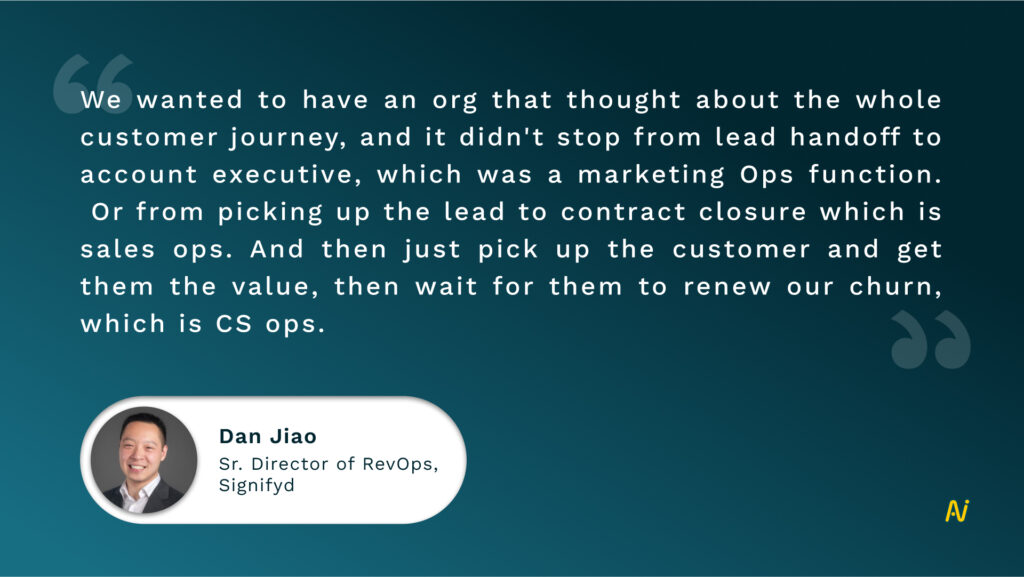
How Silos Manifest in GTM Ops
Silos can manifest in any of the 4 GTM areas – tools, systems, processes and data.
1. Tools and Systems
But as Dan points out,
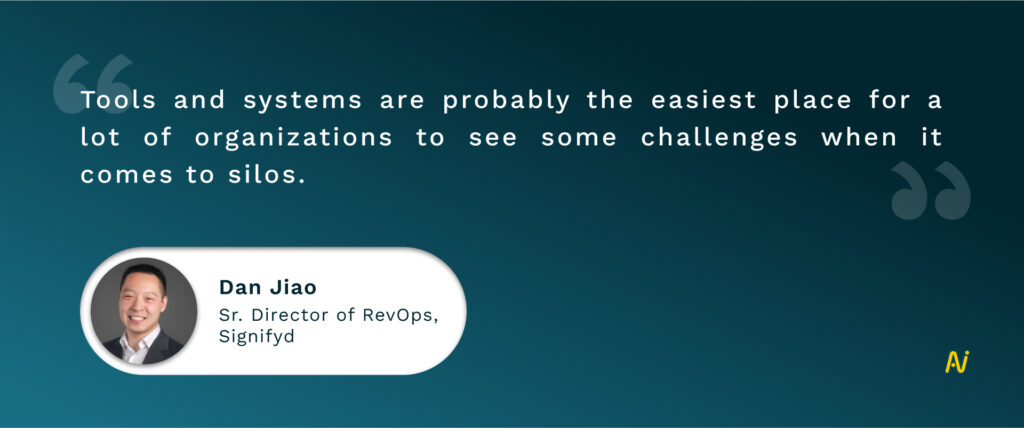
Today, every organization (big and small) has a relatively sizable tech stack to make GTM workflows actually work. This tech stack also supports growing teams.
Each tool in the stack has specific use cases like conversational intelligence, forecasting, analytics, or something else. But with a disintegrated tech stack, you could just be piling on tools with similar or the same functions for different teams.
That’s what Signifyd noticed in 2021 before Dan arrived at the company. They invested in several tools, coming off the back of a funding round. And while Signifyd still uses several of those tools to maintain a good tech stack, some tools have overlapping functions.
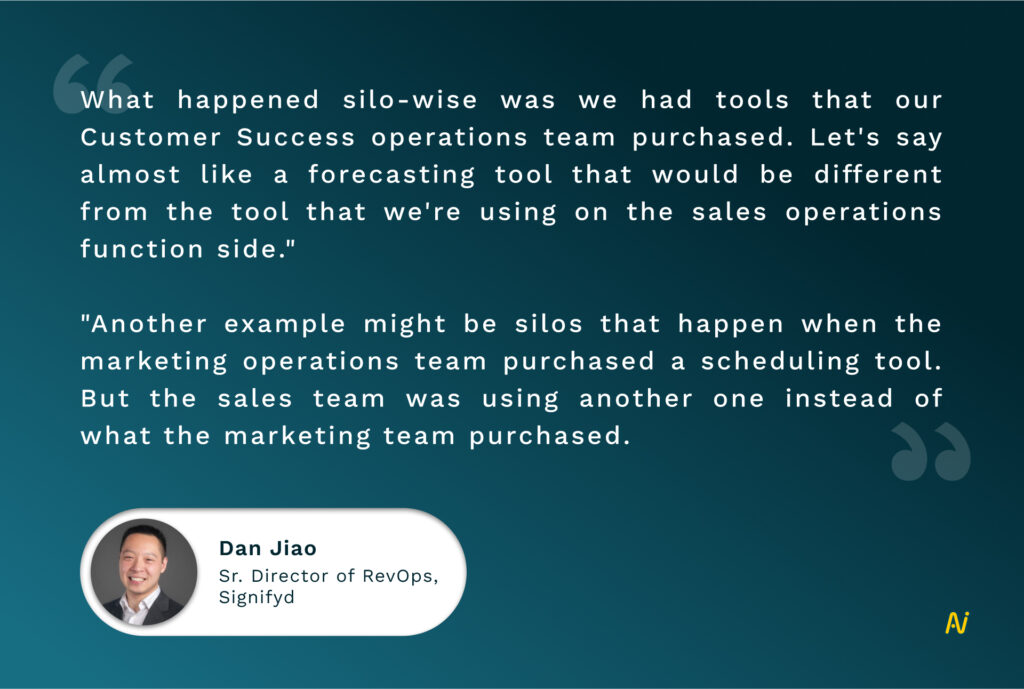
2. Data
Data plays a significant role in building or breaking down silos. It’s at the very center of the GTM tech stack, keeping all teams in the loop about leads, customers, and revenue performance.
Data helps you dig into insights and make critical decisions.
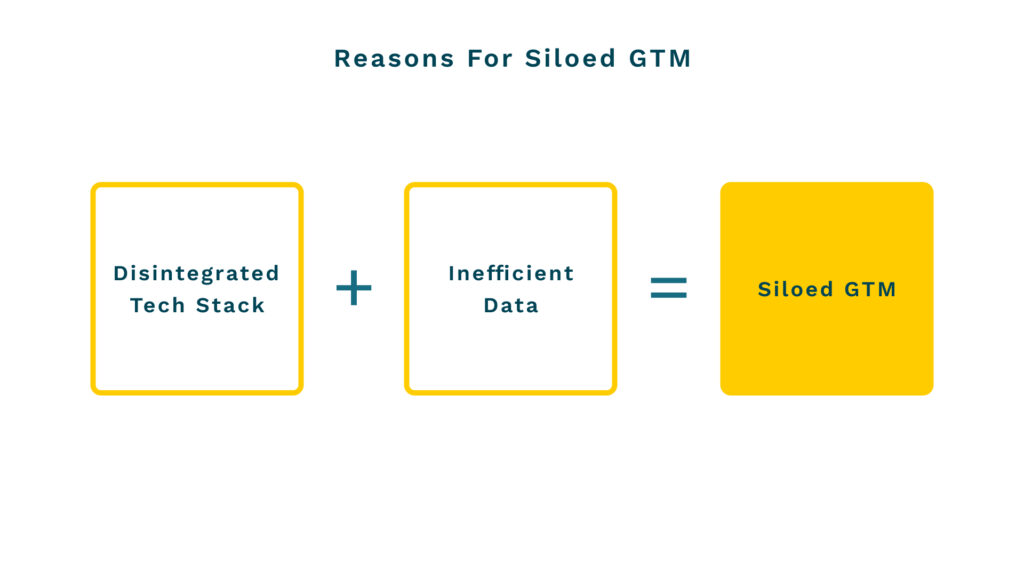
But as businesses grow, so does the volume of data. Plus, as technology progresses, the amount of data generated keeps increasing.
That’s where silos in data can hamper even near-perfect GTM operations.
For 90% of organizations, data silos are a major challenge to growth.
Siloed data is stored in isolated tech stacks, wherein each team uses its own tools. Data is controlled by the team that owns it but is inaccessible to others.
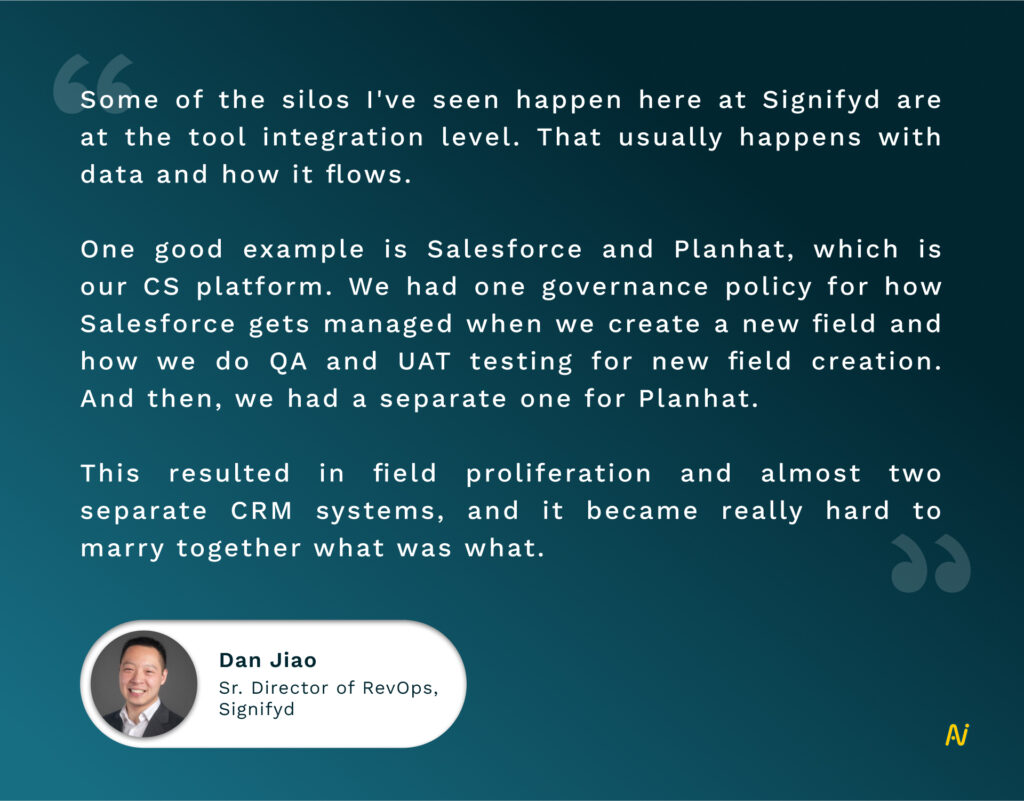
Siloed data takes away from what GTM is meant to be—a unification of efforts between revenue-generating functions.

Data silos are not good for business. They create confusion, misaligned goals, internal competition, isolated thinking, and stunted growth.
Make the Move to RevOps for Breaking Down Silos
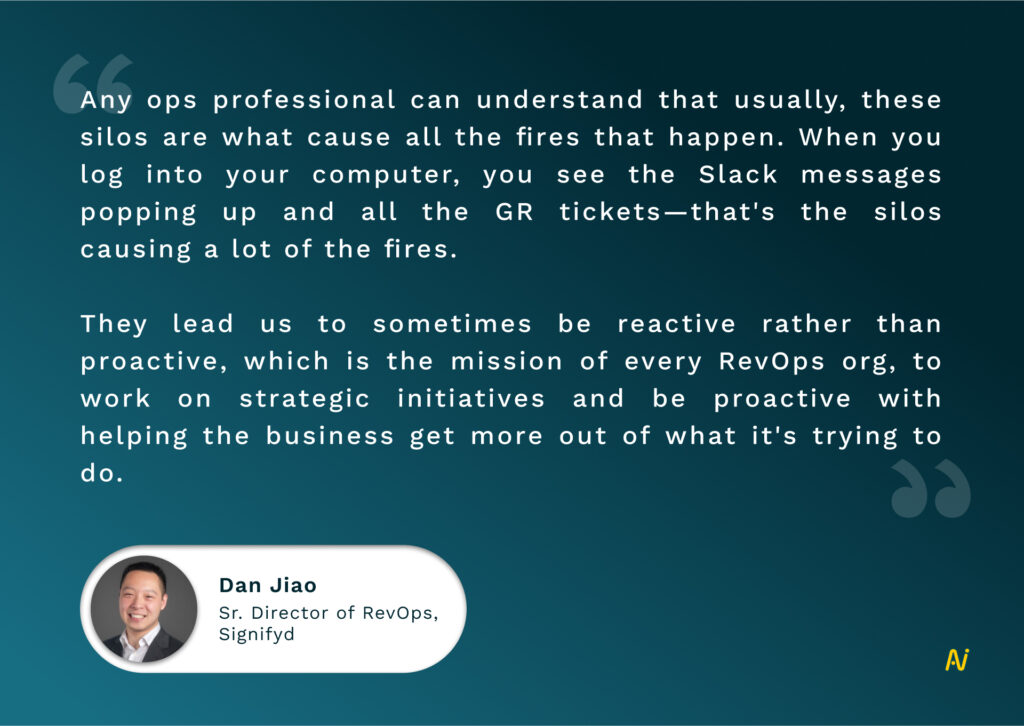
Dan pointed out the biggest pain point cropping up, courtesy of silos. Here are 5 more reasons why you should turn to RevOps for breaking down silos.
1. To Provide a Connected Customer Experience
Over 54% of organizations still find it difficult to provide a connected customer experience across multiple channels. A streamlined experience increases customer engagement and pipeline visibility for you.
2. To Improve Cross-Functional Collaboration
RevOps facilitates shared goals, processes, and a common language between all customer-facing teams. It helps in breaking down silos so each team understands the other’s goals, objectives, and responsibilities.
This clarifies each team’s role and overall contribution to GTM.
3. To Stay On Top of Business Opportunities
Using reliable data, RevOps creates clarity on pipeline visibility, upsells, and cross-sells. And with visibility comes deeper insights into business opportunities.
Organizations that believe in clean data are 23 times more likely to acquire new customers, 6 times more likely to retain them, and 19 times more likely to be profitable.
4. To Make More Effective Forecasts
Less than 25% of sales organizations have a sales forecasting accuracy of 75% or higher. RevOps can improve your forecasting effectiveness with shared information presenting a more complete picture.
5. To Simplify Work for Everyone Involved
RevOps makes work easier for all teams and leaders involved in GTM by breaking down silos. It improves productivity and enables more streamlined workflows.
Instead of spending time searching for information and going back and forth with each other, teams focus on aligning their individual goals with the business.
Breaking Down Silos at Signifyd With RevOps
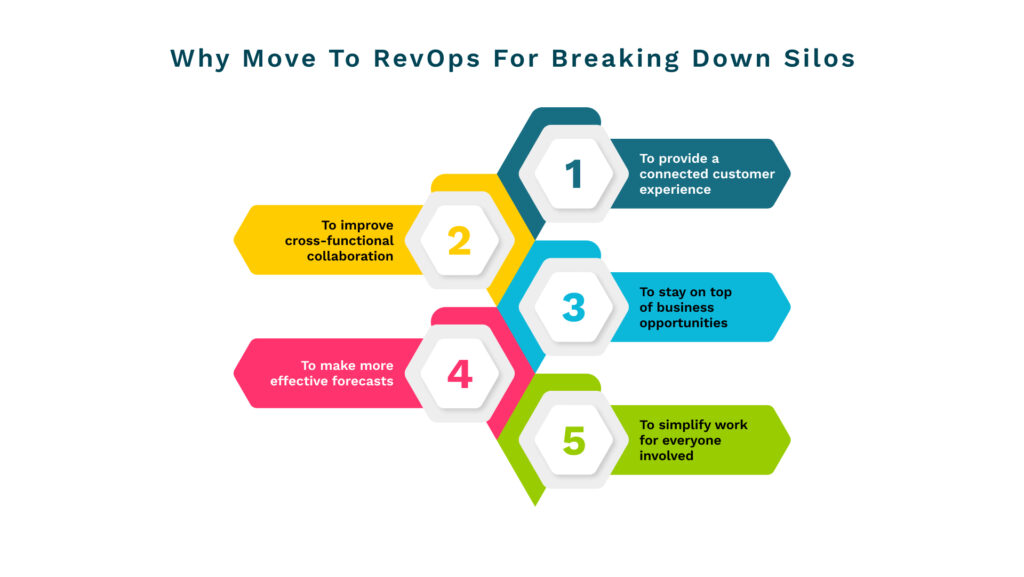
Signifyd formally introduced its RevOps process in November 2022. However, a soft initiation was already underway since mid-2022.
Before RevOps, Signifyd primarily operated as a remote hybrid model, mainly conducting business over virtual calls. At Dan’s suggestion, the company arranged an off-site meetup at their HQ in San Jose.
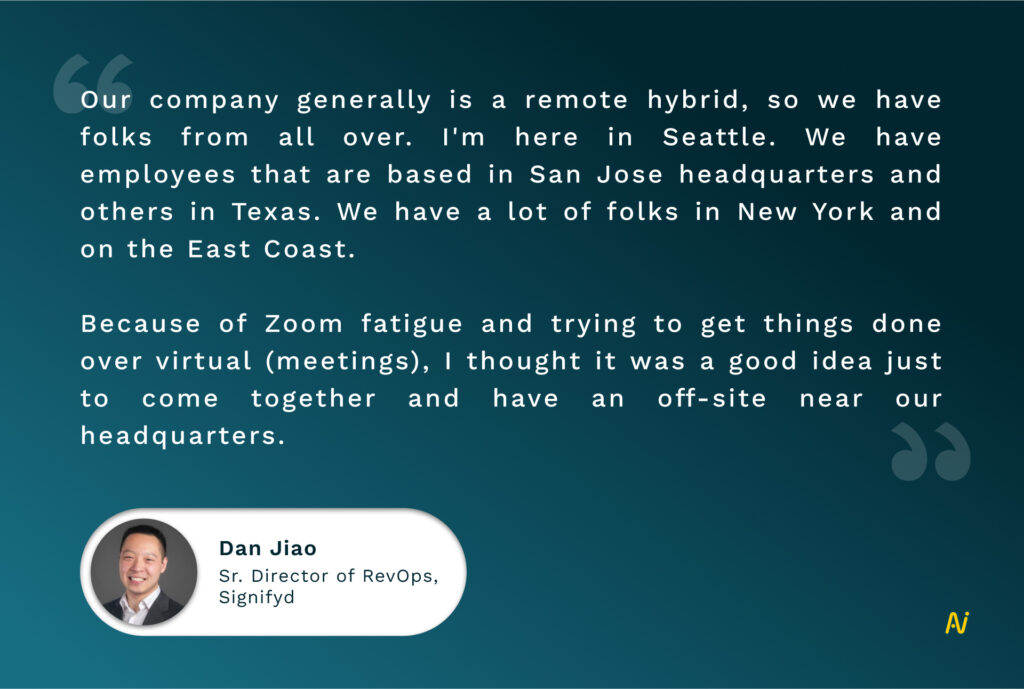
As the teams came together, they started exchanging knowledge and ideas of how to enable each other better. And that’s where the seeds of RevOps were first sown at Signifyd.
Before beginning the process, however, Dan wanted to clarify what a RevOps model would mean for the company.

And once the purpose behind RevOps was clear, Signifyd started strategizing for adoption and breaking down data silos.
Adopting the RevOps Model With Executive Buy-in
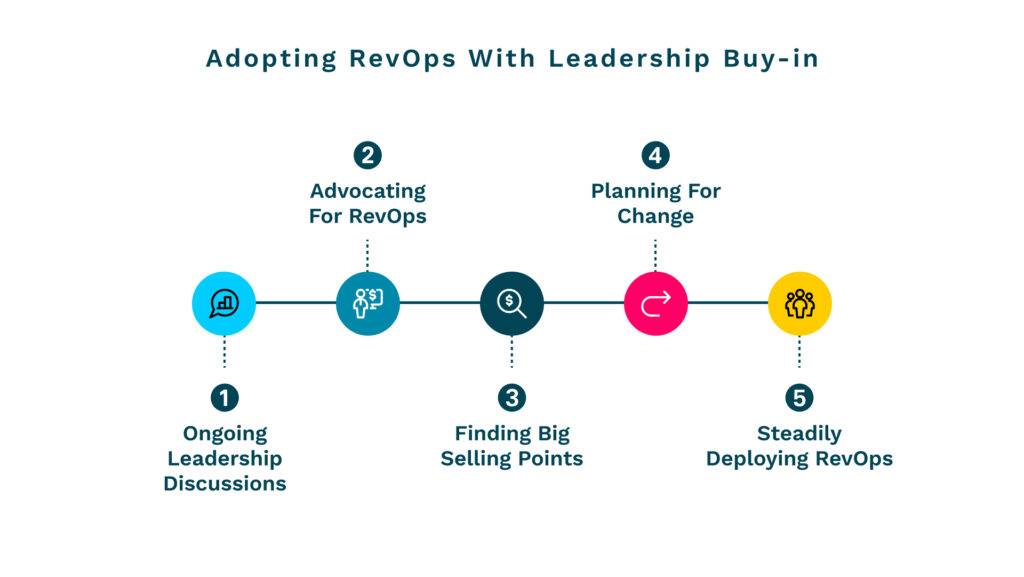
Having a streamlined GTM process was something that the executives at Signifyd had always set their minds on. And so, executive decision-making regarding RevOps was already a work in progress when Dan joined.
The senior vice president (SVP) and C-suite were involved in discussions of setting up a RevOps-like function. Dan advocated for seeing this through and making the RevOps model a reality.
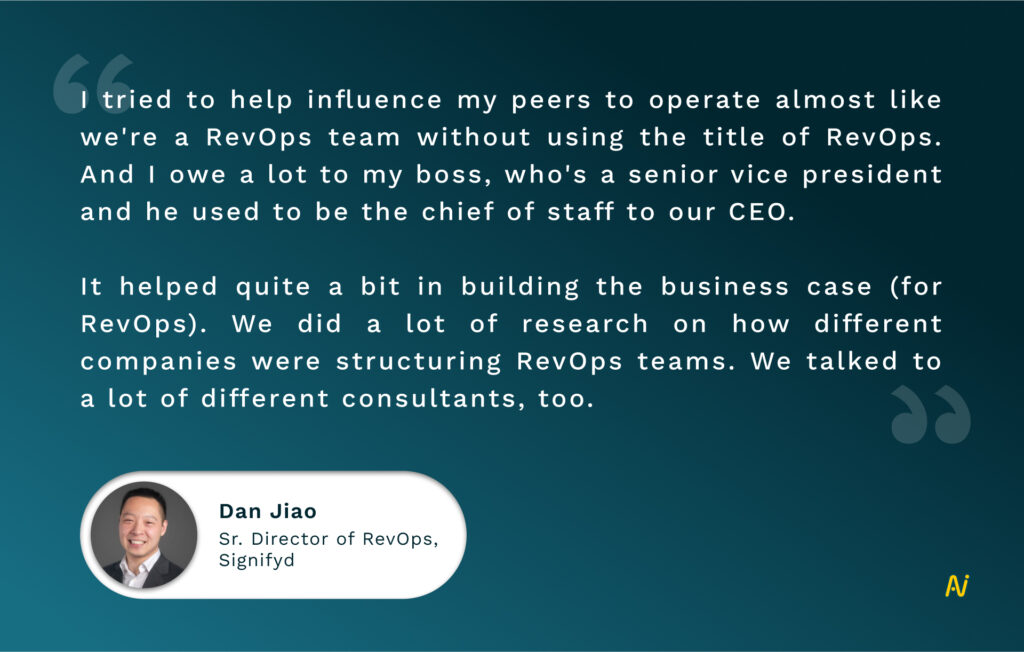
To encourage leadership buy-in, Dan also focused on finding some of the most significant selling points for RevOps.
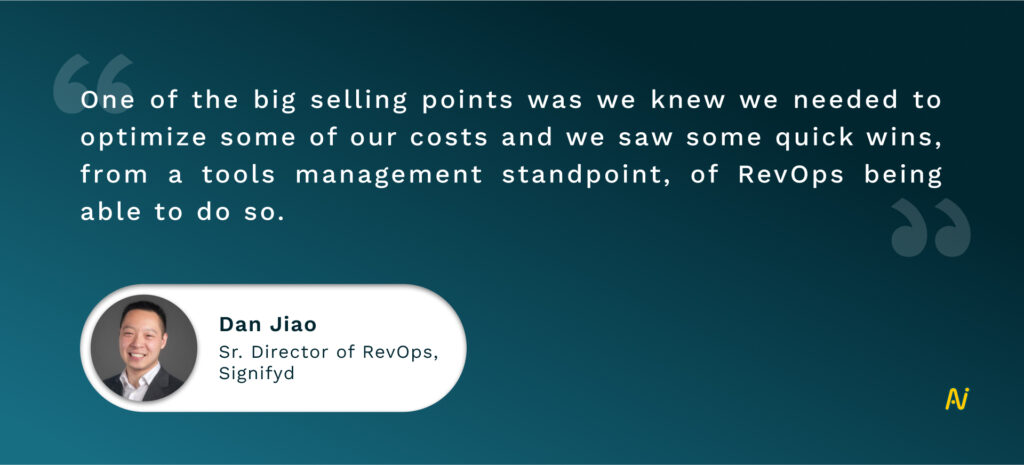
Dan and his team looked at the company’s big initiatives like lead management scoring, routing, named accounts and sales territory structure, and account prioritization, where there were multiple handoff processes.
He realized these weren’t a single team’s problems but just GTM problems. And that became a key selling point for RevOps.
Even then, the decision to develop and implement RevOps wasn’t hasty. Signifyd needed to think about managing change at the organizational level carefully.

Once change management and adoption fell into place, Signifyd wrote its own RevOps charter. Dan was promoted to lead all revenue operations, including marketing, sales, and customer success. But what Dan did differently was that he structured RevOps around functional skills rather than separate teams.
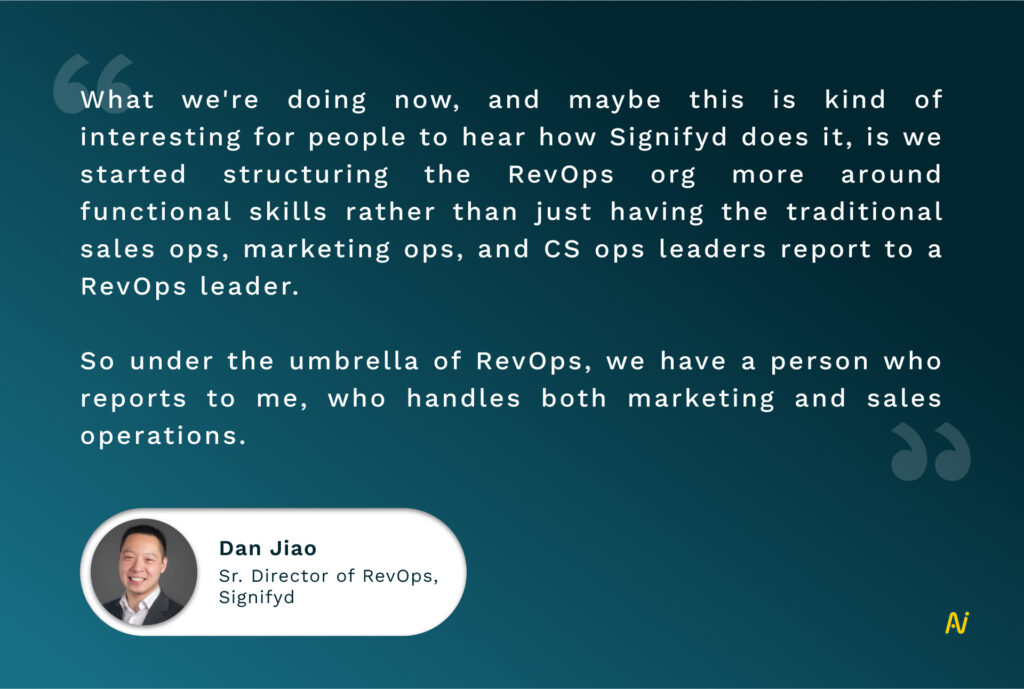
Finally, Signifyd is setting up a different leadership position for revenue tech. This leader will own the tools, systems, reporting, and analytics infrastructure for GTM.
Seeing RevOps in Action at Signifyd
Signifyd implemented RevOps for breaking down silos by putting 5 key activities in motion.
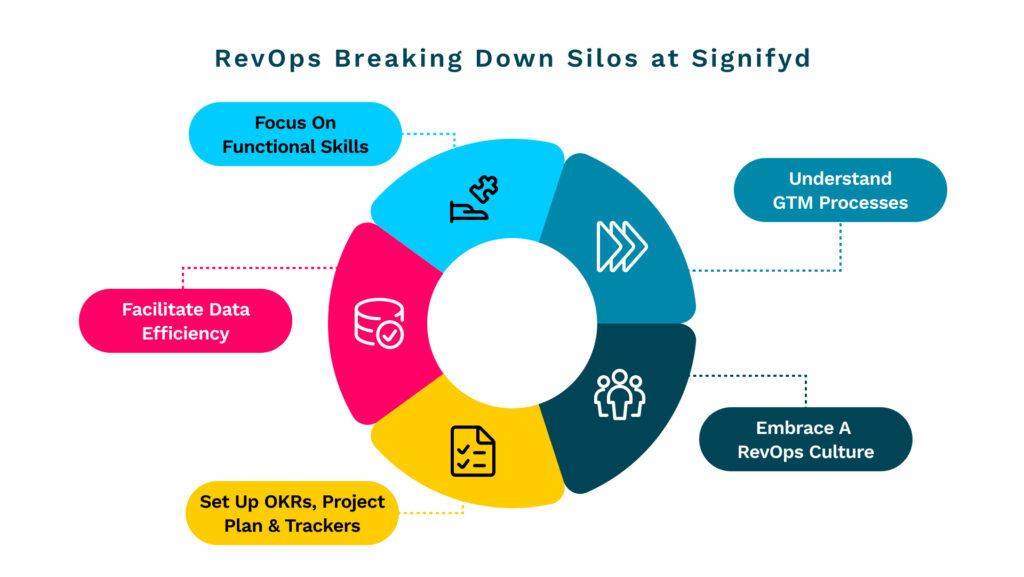
1. Understanding the GTM Processes Well
Teams must be aware of and understand the GTM processes beyond their responsibilities. Instead of being laser-focused on achieving separate team goals, all teams work towards the same business goals.
A matured understanding of GTM and its processes creates the first level of clarity for deploying RevOps at the organization.
2. Embracing a RevOps Culture
Process changes in the organization need changes at the cultural level, too.
Traditional GTM thinking keeps marketing, sales, and customer success functions in silos. Even if operations may be centralized, each team sees itself as a distinct function.
For breaking down silos, teams need to foster collaboration, even in day-to-day activities. And that’s one of the first steps Signifyd took.
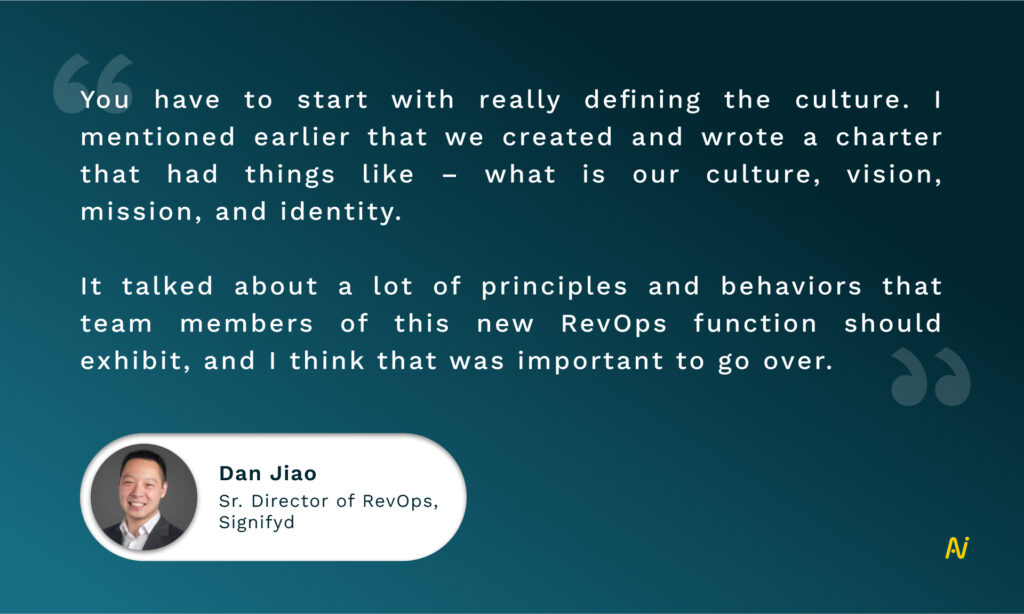
To embrace a RevOps culture, teams and leaders need a deeper understanding of employees’ GTM pains. It helps solve problems faster and gives a diverse perspective of all functions.
Thinking differently about goals and roles in the overall business context encourages cultural change. All teams end up wanting the same thing—to grow revenue efficiently.
3. Setting up OKRs, Project Plans and Trackers
Objectives and key results (OKRs) are used to set goals and milestones. They show you what to measure, how to determine ongoing progress, and what tasks to prioritize. OKRs help you adapt your strategy to changes.
Next is setting up a project plan to show how you will achieve these OKRs. A project plan includes goals, non-goals, what’s in the scope and what’s not.
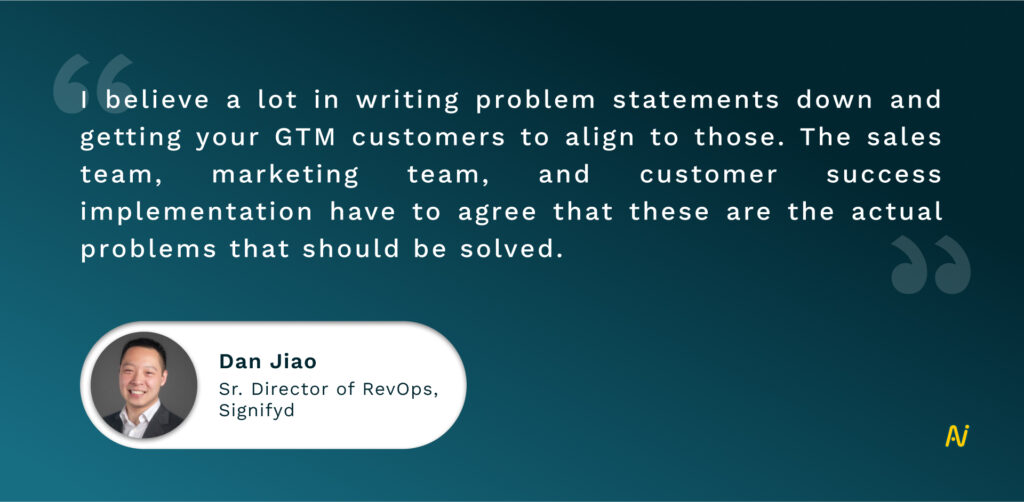
Finally, a tracker updates tasks, ensuring everyone in RevOps is accountable for their work and performance.
4. Facilitating Data Efficiencies
Data, as we discussed earlier, is critical for a successful GTM process.
But when people generate data fields on several different systems, no single team or individual rep knows what information to trust for decision-making.
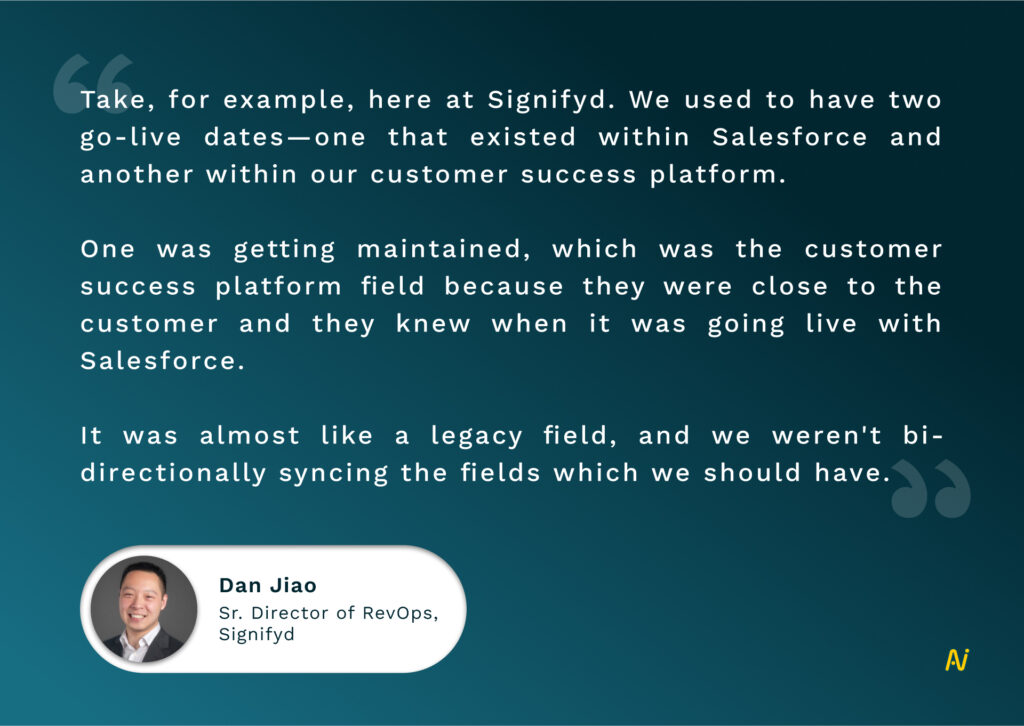
Signifyd looked at all the data and vital insights needed for executive decision-making. Then, the team also looked at functional insights and contributor-level data. It finally came down to documenting their data to establish a single source of truth.
Even more minor things, like clarifying “what each field means,” goes a long way in breaking down data silos and getting your teams to speak a common data language.
5. Focussing on Functional Skills
Instead of continuing to separate teams as marketing, sales, and customer success, Dan turned his attention to functional skills.
Signifyd established a process and project management team to handle top-of-the-funnel activities and pre-sales. Another team handles post-sales, which includes customer success, product implementation, referrals, onboarding, advocacy, upsells, and expansions.
It facilitated clear and seamless communication between pre-sales and post-sales to standardize opportunity management.
After putting their RevOps model through the wringer, Signifyd has seen some early yet clear benefits.
Early Results Hold Promise of Revenue Growth for Signifyd
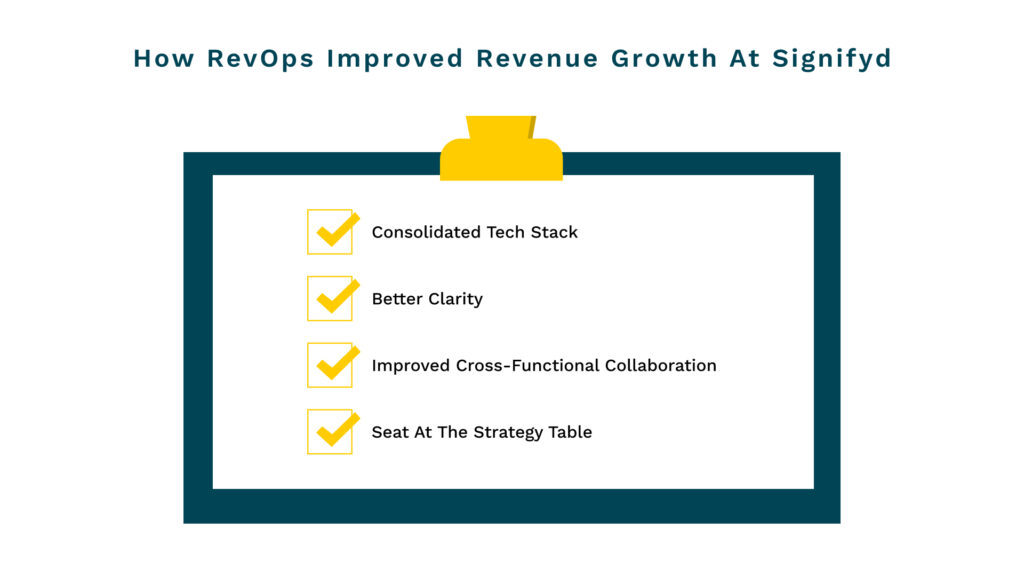
Dan has seen some early benefits of adopting a RevOps model at Signifyd, mainly breaking down data silos through:
1. Consolidated Tech Stack
One of the leading indicators is a consolidated tech stack. This tech stack has saved costs and helped better understand what tools the company should invest in and how they can operationalize them.
For instance, Signifyd has worked with a few tools in the year’s first half. These include tools for account prioritization, forecasting, and executive insights. And the team can now extract excellent ROI from the tools.
2. Better Clarity
The second leading indicator, which is more of a non-measurable benefit, is improved clarity and focus.
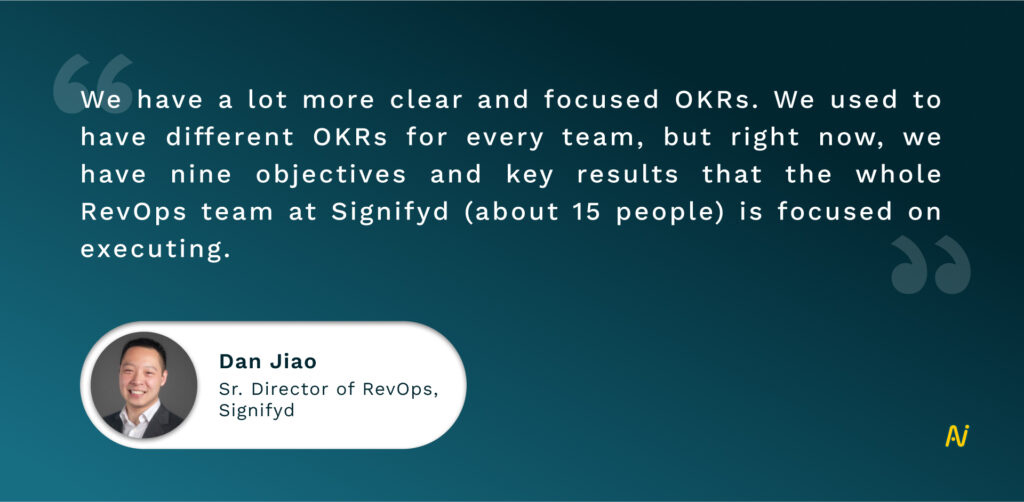
3. Improved Cross-Functional Communication
Seamless cross-functional communication enables Signifyd’s revenue teams to grow by taking ownership of tasks.

4. A Seat at the Strategy Table
At Signifyd, RevOps now holds a seat at the strategy table. Dan and some of his team members help strategize for RevOps alongside other executives.
RevOps also discusses major process changes that the company wants to roll out in the organization.
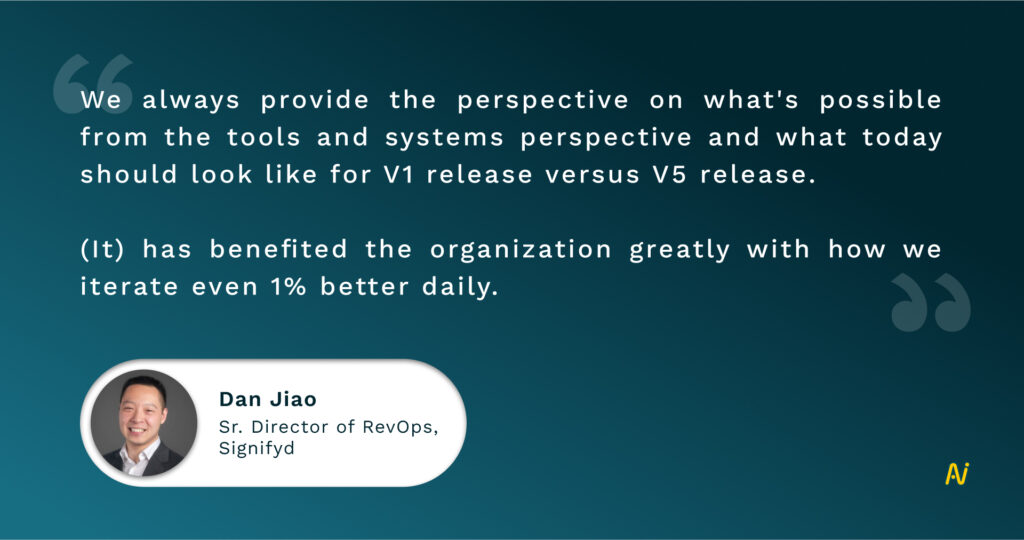
Transition to a RevOps Model With Unified Data
Signifyd’s progress with RevOps enabled breaking down silos and allowing cross-functional collaboration to work towards revenue growth.
You can achieve success with RevOps, too. And the first place to begin is data silos. Don’t be intimidated by taking it on because that’s precisely what Nektar helps with.
We address the data challenge by solving the foundational problem of GTM silos – dirty data. Nektar unifies contact and activity data capture, streamlining GTM throughout the customer journey.
You get clear pipeline visibility for a true view of revenue intelligence. Accurate and complete CRM data creates a single source of truth for actionable insights, so leaders and teams can make informed decisions.
Nektar also integrates across the revenue tech hub to maximize ROI from your tech stack.
To learn more about how Nektar fits into the RevOps model, contact our team.
But why stop there? We also consolidated our ultimate guide to RevOps roadmap ebook after speaking to 150+ revenue leaders. In this free guide, you’ll find templates, checklists and plans on how to build your very own RevOps roadmap!








